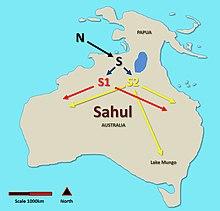| Haplogroup S | |
|---|---|
| Possible time of origin | 64,000-47,000 years ago |
| Possible place of origin | Australia |
| Ancestor | N |
| Descendants | S1, S2, S3, S4, S5, S6 |
| Defining mutations | 8404[1] |
In human genetics, Haplogroup S is a human mitochondrial DNA (mtDNA) haplogroup found only in Australia. It is a descendant of macrohaplogroup N.
Origin
Haplogroup S mtDNA evolved within Australia between 64,000 and 40,000 years ago (51 kya).[2]
Distribution
It is found in Aboriginal Australians.[3] Haplogroup S2 found in Willandra Lakes human remain WLH4 dated back Late Holocene (3,000-500 years ago).[4][5]
Subclades
Tree
This phylogenetic tree of haplogroup S subclades is based on the paper by Mannis van Oven and Manfred Kayser Updated comprehensive phylogenetic tree of global human mitochondrial DNA variation[1] and subsequent published research. The TMRCA for haplogroup S is between 49 and 51 KYA according to Nano Nagle's Aboriginal Australian mitochondrial genome variation – an increased understanding of population antiquity and diversity publication that published in 2017.[2]
- S (64-40 kya) in Australia
- S1 (53-32 kya) in Australia
- S1a (44-29 kya) found in WA, NT, QLD and NSW
- S1b (37-22 kya) found in NT, QLD and NSW
- S1b1 (30-10 kya) found in NT and QLD
- S1b1a (24-6 kya) found in QLD
- S1b2 (17-3 kya) found in QLD
- S1b3 (20-4 kya) found in QLD and NSW
- S1b1 (30-10 kya) found in NT and QLD
- S2 (44-22 kya) in Australia
- S2a (38-18 kya) found in NT, QLD, NSW and TAS
- S2a1 (31-12 kya) found in NSW, QLD and TAS
- S2a1a (19-6 kya) found in NSW and QLD
- S2a2 (38-11 kya) found in NT, QLD and NSW
- S2a1 (31-12 kya) found in NSW, QLD and TAS
- S2b (42-18 kya) found in WA, NT, QLD and VIC
- S2b1(27-9 kya) found in NT, QLD and VIC
- S2b2 (37-12 kya) found in WA, NT and QLD
- S2a (38-18 kya) found in NT, QLD, NSW and TAS
- S3 (17-1 kya) found in NT
- S4 found in NT
- S5 found in WA
- S6 found in NSW
- S1 (53-32 kya) in Australia
See also
| Phylogenetic tree of human mitochondrial DNA (mtDNA) haplogroups | |||||||||||||||||||||||||||||||||||||||
| Mitochondrial Eve (L) | |||||||||||||||||||||||||||||||||||||||
| L0 | L1–6 | ||||||||||||||||||||||||||||||||||||||
| L1 | L2 | L3 | L4 | L5 | L6 | ||||||||||||||||||||||||||||||||||
| M | N | ||||||||||||||||||||||||||||||||||||||
| CZ | D | E | G | Q | O | A | S | R | I | W | X | Y | |||||||||||||||||||||||||||
| C | Z | B | F | R0 | pre-JT | P | U | ||||||||||||||||||||||||||||||||
| HV | JT | K | |||||||||||||||||||||||||||||||||||||
| H | V | J | T | ||||||||||||||||||||||||||||||||||||
References
- ^ a b van Oven, Mannis; Kayser, Manfred (February 2009). "Updated comprehensive phylogenetic tree of global human mitochondrial DNA variation". Human Mutation. 30 (2): E386–E394. doi:10.1002/humu.20921. PMID 18853457. S2CID 27566749.
- ^ a b Nagle, Nano; van Oven, Mannis; Wilcox, Stephen; van Holst Pellekaan, Sheila; Tyler-Smith, Chris; Xue, Yali; Ballantyne, Kaye N.; Wilcox, Leah; Papac, Luka; Cooke, Karen; van Oorschot, Roland A. H.; McAllister, Peter; Williams, Lesley; Kayser, Manfred; Mitchell, R. John (March 2017). "Aboriginal Australian mitochondrial genome variation – an increased understanding of population antiquity and diversity". Scientific Reports. 7 (1): 43041. doi:10.1038/srep43041. PMC 5347126. PMID 28287095.
- ^ Haplogroup S.
- ^ Lambert, David; Wright, Joanne; Westaway, Michael; Subramanian, Sankar (8 June 2016). "New DNA study confirms ancient Aborigines were the First Australians". The Conversation.
- ^ Heupink, Tim H.; Subramanian, Sankar; Wright, Joanne L.; Endicott, Phillip; Westaway, Michael Carrington; Huynen, Leon; Parson, Walther; Millar, Craig D.; Willerslev, Eske; Lambert, David M. (21 June 2016). "Ancient mtDNA sequences from the First Australians revisited". Proceedings of the National Academy of Sciences. 113 (25): 6892–6897. doi:10.1073/pnas.1521066113. PMC 4922152. PMID 27274055.
External links
- Ian Logan's Mitochondrial DNA Site
- Mannis van Oven's Phylotree
